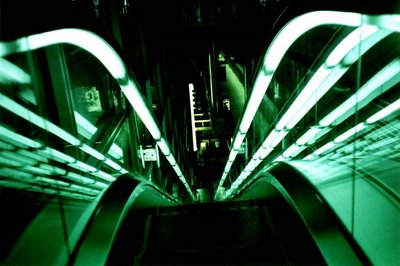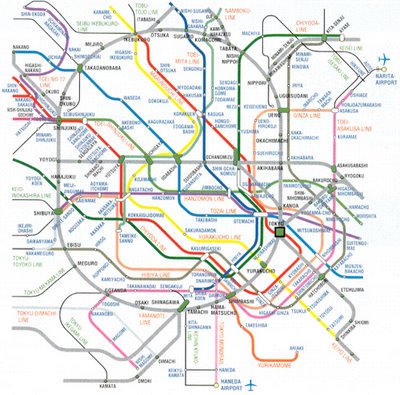This is an old story, but I still like telling it. Japanese researcher Shun Akiba has apparently discovered “hundreds of kilometers of Tokyo tunnels whose purpose is unknown and whose very existence is denied.”
 [Image: From the LOMO Tokyo flickr pool; image by someone called wooooooo].
[Image: From the LOMO Tokyo flickr pool; image by someone called wooooooo].
Shun, who believes he is now the victim of a conspiracy, stumbled upon “an old map in a secondhand bookstore. Comparing it to a contemporary map, he found significant variations. ‘Close to the Diet in Nagata-cho, current maps show two subways crossing. In the old map, they are parallel.'”
This unexpected parallelization of Tokyo’s subway tunnels – a geometrician’s secret fantasy – inspired Shun to seek out old municipal construction records. When no one wanted to help, however, treating him as if he were drunk or crazy – their “lips zipped tight” – he woke up to find his thighs sealed together with a transparent, jelly-like substance –
Er –
Actually, he was so invigorated by this mysterious lack of interest that “he set out to prove that the two subway tunnels could not cross: ‘Engineering cannot lie.'”
But engineers can.
To make a long story short, there are “seven riddles” about this underground world, a secret Subtokyo of tunnels; the parallel subways were only mystery number one: “The second reveals a secret underground complex between Kokkai-gijidomae and the prime minister’s residence. A prewar map (riddle No. 3) shows the Diet in a huge empty space surrounded by paddy fields: ‘What was the military covering up?’ New maps (No. 4) are full of inconsistencies: ‘People are still trying to hide things.’ The postwar General Headquarters (No. 5) was a most mysterious place. Eidan’s records of the construction of the Hibiya Line (No. 6) are hazy to say the least. As for the ‘new’ O-Edo Line (No. 7), ‘that existed already.’ Which begs the question, where did all the money go allocated for the tunneling?”
Shun even “claims to have uncovered a secret code that links a complex network of tunnels unknown to the general public. ‘Every city with a historic subterranean transport system has secrets,’ he says. ‘In London, for example, some lines are near the surface and others very deep, for no obvious reason.'” (Though everyone knows the Tube is a weaving diagram for extraterrestrials).

Further, Shun reveals, “on the Ginza subway from Suehirocho to Kanda,” there are “many mysterious tunnels leading off from the main track. ‘No such routes are shown on maps.’ Traveling from Kasumigaseki to Kokkai-gijidomae, there is a line off to the left that is not shown on any map. Nor is it indicated in subway construction records.”
Old underground car parks, unofficial basements, locked doors near public toilets – and all “within missile range of North Korea.”
What’s going on beneath Tokyo?
(Thanks to Bryan Finoki for originally pointing this out to me! For similar such explorations of underground London, see London Topological; and for more on underground Tokyo, see Pillars of Tokyo – then read about the freaky goings-on of Aum Shinrikyo, the subway-gassing Japanese supercult. And if you’ve got information on other stuff like this – send it in…)
The main article this post is citing – from the Japan Times – is registration only. To read the article I registered under some weird name I’ve now lost and I don’t feel like re-registering; but the quotations above are a fairly large percentage of the original story. But if you do decide to register, the link, supplied above, does work.
Speaking of subterranean Japan, I was just looking at the Tokyo GCANS yesterday. If you haven’t seen them, take a look here.
http://www.g-cans.jp/intro/07photo/index.html
ps, bugmenot.com
The other thing to do is, similar to the idea in this post – or, printing tourist brochures for places that don’t exist – is to print a new map of the London Underground, adding stations that no one’s ever heard of. Doing so in peripheral areas that aren’t immediately noticeable. Inserting fake stations in the London A-Z so that on page 67 you see a very clearly marked Albumuth Station… so you go looking for such a thing… and your life changes.
You end up popping anti-psychotic pills in Bedlam.
anon – Those are linked up above in the post, under the phrase “Pillars of Tokyo.” But thanks!
When this story first surfaced, I tried finding anything else about the author/story/book. All my searches were in English (damn my mono-lingualism).
They all led back to the sole article about him and his book. Unfortunately, the book has never been translated into eniglish. And no one has posted anthing in english about taking the book as a starting poiint for further exploration of underground Tokyo.
************
A good online site/zine for urban exploration is Infiltration.
It remains me strongly of an excellent book by Haruki Murakami : Hard-boiled Wonderland/End of the World. In this story, the characters go into tunnels under Tokyo haunted by strange creatures. The tunnels are described exactly as in you post, i didn’t know it was a true story. Thanks !
Monkey – Agreed, I love that book.
I wouldn’t necessarily describe this as a “true” story, on the other hand.
This is slightly off-topic, but one of the things on the Ginza line that freaked me out the last time I was in Tokyo was the strobing advertisement that appears in the train windows while travelling west. Since Japanese trains travel at very precise speeds, the static panels pasted on the walls of the tunnel appear to be animated, so one sees an animated advertisement – what apears to be a film – of a man shaving his face.
It would never work in Sydney, of course. Here we can barely get the trains to run at all. In Tokyo they run so precisely that this kind of animated ad is apparently easy to set up.
Anon – There was something like that proposed, and sort of prototyped, if I remember right, back in Berlin in about 2001, but using paint and abstract designs – the idea was that as you left the station, by U-Bahn, it looked as if the walls had been turned into cinemas.
Robert, meanwhile, another good urban exploration site is the urban exploration webring…
“A map, as my friend Yelov used to say, is called in a certain language by the word khormanoupka, which means ‘wisdom’, and ‘wisdom’ in that language is characterized as follows:
‘Mental proof that twice to makes seven and a half, minus three and a little bit of something.'”
— Gurdjieff, Meetings with Remarkable Men (Piotr Karpenko)
Geoff, apropos of your faux-maps and your earlier post about The Island of New Ephemera — I wanted to namecheck artist Alexandra Mir, who took a map of metropolitan Tokyo, where the streets really *do* (sorry, Bono) have no names, and superimposed names upon it based on suggestions from friends, fellow artists and random would-be geographers. One guy named his section after furniture designers. Another woman named her streets with faux-Japanese words. My least favorite cultural theorist, Andrew Ross, names his after streets from his ironic pet town of Celebration, FL. Etc., etc.
Black Panthers mingle promiscuously with Richard Nixon; Brazil’s sex goddess (Brazil has a sex goddess?) holds court with Blinky the Friendly Hen; and finally (thank the Borgesian deities, and thank Funes for remembering!) Pierre Menard gets a street named after him….
http://www.aleksandramir.info/projects/tokyo/tokyo.html
D
Amazing story!
Musakami already invoked… those INKlings wet and horrid in the subway nooks.
Last night I finshed Murakami’s Underground, and the image of tunnels reorganizing themselves around the hurtling trains would fit well in that book. Instead – echoing the split-brainer in Hard Boiled – it’s the neural paths of AUM renunciates bending around the twisted will of Asahara, and the nerves of commuters forever shifted and scarred by sarin gas.
The stories of Aum members at the book’s end overlaps with Ballard’s Super-Cannes as well – highly trained and skilled elites medling with moral order, commanded by a spiritual mentor with apocalyptic visions. Murakami suggests that AUM operated as a frontier for elites who vacated the homeland of Japanese society, and that this parallels the WWII frontier of occupied Manchuria (tales of which he tackles in Wind-up Bird Chronicles)…
Just to add $.02…
as a current resideent of Japan, I’d like to point out that I have yet to encounter an accurate map published by any public authority, especially in the realm of things consistently existing and in matters of scale. Its kind of a game they have here, maybe some sort of darwinian tactic against overpopulation.
Dan (Dan, right?), thanks for the Aleksandra Mir link – but I think the truly avant-garde Tokyan cartographer would rename the streets and subway stations of Tokyo after the street names and subway stations – of Tokyo. Scott/Museum, meanwhile, that sounds like an amazing book, and it’s on my list of things to check out – once I recover from cardiac arrest due to all the other shit I have to read. The history of the Manchurian nation-free zone sounds like something to look into…
And, anon, that’s hilarious, good luck over there. Make your own maps, maybe. They’d be at least as accurate, no?
Anyone here read The Method Actors? Or Mitchell?
And Chuck, that’s insane. But very wise.
From the article: ‘Every city with a historic subterranean transport system has secrets,’ he says. ‘In London, for example, some lines are near the surface and others very deep, for no obvious reason.’
I don’t think that’s true at all. The subsurface tubes are limited to the earliest lines. It’s very disruptive to build a subsurface tunnel; the District Line along the Thames, for example, was built as part of a wholesale redevelopment (the Victoria Embankment) which also included sewers and roads.
The deep tunnels came later, and although at first they were (legally, not technically) confined to following roads (ever wondered why the Central at Bank has that awful curve? It’s turning left under Threadneedle Streeet and Old Broad Street), they were soon allowed a freedom of alignment that wasn’t there for subsurface lines.
Of course, some lines are a bit deeper than others, but that’s usually determined by a mix of interchanges (can’t have two tubes at the same level, unless they’re parallel) or geology (you want good clay, which is also the reason the Tube didn’t impinge much on South London).
OK, so this isn’t obvious to everyone, and I know this is all much more prosiac than the Maramuki-inspired other comments, but I thought I’d at it anyway.
Blech, I agree, the claim that no one knows why London’s Tubes are built at different levels is ridiculous.
Of course, they were built like that to attract aliens…
I read somewhere (sorry for this terrible tease) that local neighborhoods don’t provide maps, that you need a guide to navigate them, as the neighborhood groups are very private about this for reasons of security.
I would also like to mention under ground tunnels in Asheville NC accessed in the past by locals (but no longer for reasons of security) behind bars like the greenman… And tunnels in Savanah GA where pirates would drag victims to their new jobs after they recovered from the mickeys…